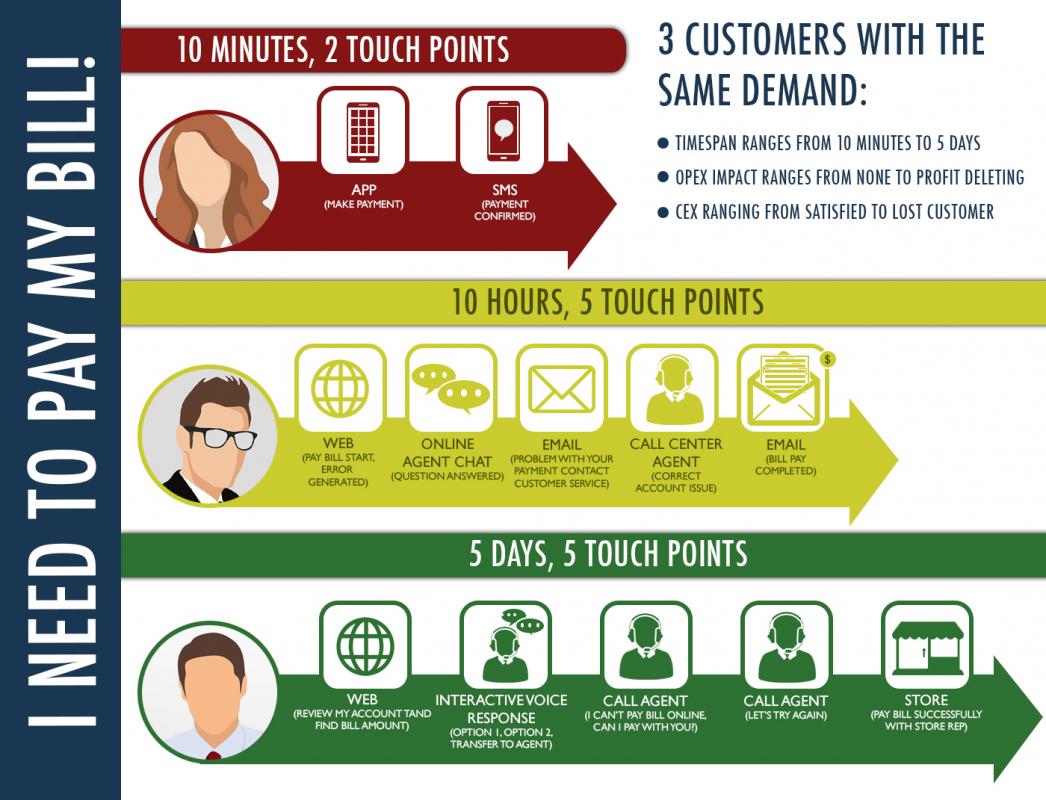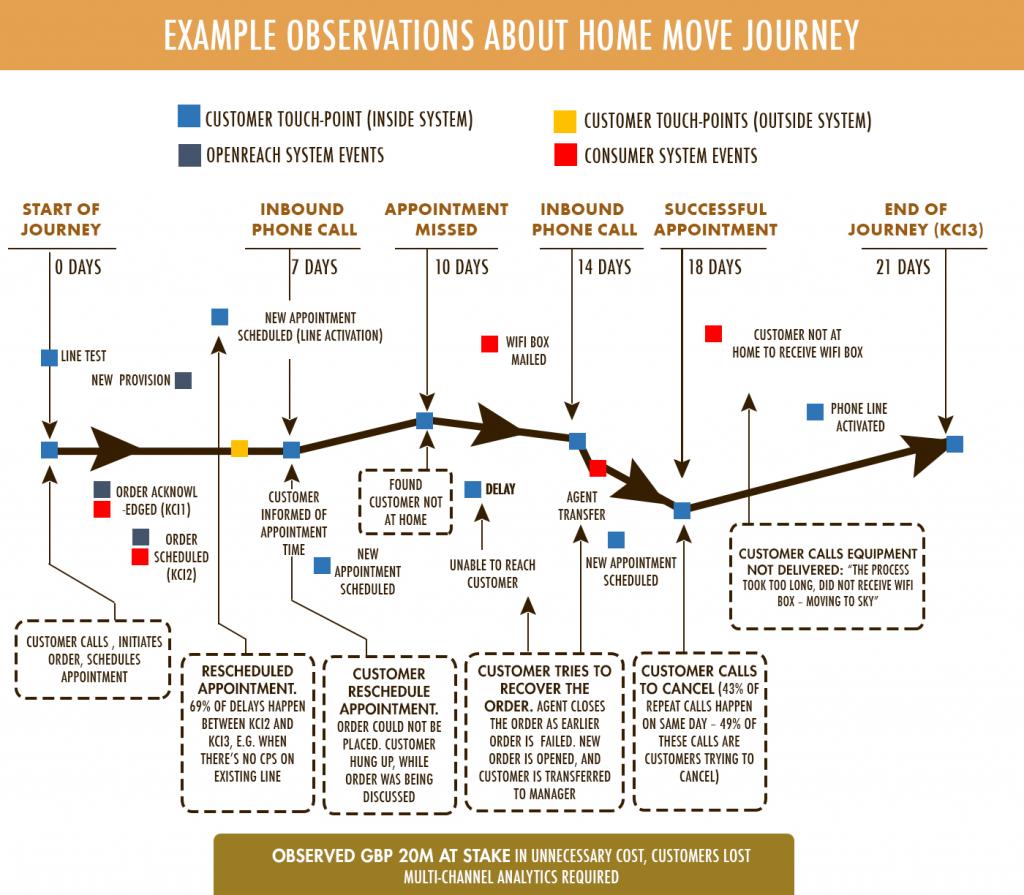
Journey Science, being derived from connected data from different customer activities, has become pivotal for the telecommunications industry, providing the means to drastically improve the customer experience and retention. It has the ability to link together scattered pieces of data, and enhance a telco business’s objectives. Siloed approaches are becoming obsolete – take call centers as an example – there is only so much that you can do with data from only one system.
By using insights from customer journey analytics, telco businesses can better measure the user experience, and make informed decision for refining it. The data not only allow them to take proactive approach towards customer satisfaction, but enable the prediction of future failures as well. With customer journey analytics, you can evaluate the touchpoints to journeys, and revamp your strategies to better cater to customers’ needs.
In the telecom industry, it is difficult for a business to effectively manage the massive volume of data with the existing systems and technology. There are several aspects where telecom companies need to make improvements, such as reduce costs, improve customer experience, increase conversion rates, and many more. To do so, they need to derive meaning from the collected data by finding connections among them. This linked data is also known as journeys. Journeys provide you with relevant data that enable you to make well-grounded business decisions by looking at customer transactions as a whole, and determining where direct improvements are needed.
Customer Journey Analytics is Transforming Telecommunications
Many leading telco businesses are embracing the Journey Science concept, and deem it to be the best way to make greater impact on the target audience. One good way to better understand digital journeys is through a multi-channel, end-2-end, view. Journey Sciences, at its best, provides enhanced data accessibility and increased analytics agility, and helps in weaving together disparate pieces of data. This makes it possible for telco businesses to link together structured and unstructured data back to their strategic objectives, and quickly modify them to ensure they cope with the evolving customer demands. However, in order to get insight into customer experience through journey analytics, it is critical to focus not only on the individual moments but the customers’ end-to-end experiences as well.
Customer Experience Boost
The main benefit of customer journey analytics for telco companies is that it enables them to better recognize customer needs, and assess their satisfaction level. While most people think Journey Science is all about marketing, it mainly focuses on the services domain. For example, a customer seeking technical support for their device has multiple paths to resolution. Journey Science enables businesses to evaluate each step of the journey experience, and figure out the critical points that could negatively impact customer experience. With this kind of information, businesses can develop strategies to overcome hurdles customers face on all such touchpoints, resulting in improved customer experience.
Improving Customer Journeys through Transparency
Connecting the Dots
For improving customer experience, it is essential to connect all the data down to the individual customer level to fully understand the required changes. For telco businesses to completely understand customer journeys, they must gather data from many different channels, and track the individual journey the customer experiences. Typically, more than 50 percent of customers make multi-channel journeys; meaning, in order to understand their behavior, establishing connection among all the data is extremely important. Because of the deep roots of technology in today’s common lifestyle, many journeys start from digital channels, but eventually go into a human channel for completion.
Utilizing Aggregate and Raw Data
Apart from giving a complete picture of customer journeys, the analytics let you tap into different levels of aggregation, allowing you to view raw data as well. With journey mapping, telco businesses can benefit from both in-depth data points and aggregated data sets. Since a single customer journey can compile hundreds of thousands of data points, having aggregated views makes it much easier to pinpoint and prioritize the problematic areas. On the other hand, some journeys may yield unclear results, for example, unusual behavior of a customer on a webpage. In such a case, having access into the raw data renders the ability to focus on one key area and get invaluable insights.
Making Changes through Data Availability
Effective utilization of data from customer journey analytics allows telco to revamp their strategy as well as make smaller improvements on a continuous basis. Getting immediate feedback regarding a certain change is critical for understanding its impact. You can determine whether the intended results will be realized, or should you scale-up or sustain the change. However, a manual, project-based approach that only provides an overview of the required data will not be enough to transform journeys successfully. Instead, you should opt for an agile, iterative, analytic approach that uses continuous data availability.
It won’t be wrong to say that all those ad-hoc, manual, project-based approaches using snapshots of data have severe limitations.

Better data accessibility to more than 18 telco raw data sources as a prerequisite.
How the Customer Journey differs in both Fixed and Mobile Telco
Mobile (mobile data usage, subscriptions, charges, and mobile data access)
Several small customer journeys can be linked together to make improvements to a mobile telco operation. One great way is through customer engagement, i.e. moving down to individualized journeys of each customer instead of mass-segmentation. Journey Science opens doors for mobile telco companies to take personalization up a notch, and provide customized recommendations based on the journeys of each customer. You should also utilize real-time context to enhance customer engagement for better results.
Mobile customer experience comprises of several touchpoints where a subscriber interacts with a service provide agent – it can be during retail, billing, customer support, visible marketing campaigns, and others. Consider three customers below that have 3 different journeys to perform the same action.

Fixed line providers (phone, internet, entertainment).
Fixed line providers have an additional interaction channel with field technicians being deployed to customers’ homes for service. These field service appointments are a major part of customer experience and often have significant variability for different customers. Consider the following journey which involves multiple appointments, agent phone calls, and delays:

Improve key journeys for fixed Telco’s.
Journey Science is Moving towards Predictive Analytics
The Journey Science concept is increasingly becoming popular across the telco industry, as it greatly benefits by assessing journeys of individual customers and allow them to develop customized strategies. Moreover, it allows telco businesses to anticipate the potential pitfalls leading to negative customer experience and prevent it altogether. By tapping into the data from customer journey, telco can streamline their operations and provide a better, more satisfying experience to their customers.

Derived value from Customer Journey data by Journey Science & Journey Analytics.
In today’s world, customer satisfaction is the keystone for success in every industry, including telco. Businesses should turn to the Journey Science movement, and optimize their processes by carefully analyzing customer journeys and making improvements accordingly. Effective utilization of customer journey analytics leads to better redesigning efforts, ultimately reducing costs, enhancing customer experience, and stretching bottom-line.
Written with Rogier van Nieuwenhuizen, Executive Vice President EMEA at ClickFox.


27 t/m 29 oktober 2025Praktische driedaagse workshop met internationaal gerenommeerde trainer Lawrence Corr over het modelleren Datawarehouse / BI systemen op basis van dimensioneel modelleren. De workshop wordt ondersteund met vele oefeningen en pra...
29 en 30 oktober 2025 Deze 2-daagse cursus is ontworpen om dataprofessionals te voorzien van de kennis en praktische vaardigheden die nodig zijn om Knowledge Graphs en Large Language Models (LLM's) te integreren in hun workflows voor datamodel...
3 t/m 5 november 2025Praktische workshop met internationaal gerenommeerde spreker Alec Sharp over het modelleren met Entity-Relationship vanuit business perspectief. De workshop wordt ondersteund met praktijkvoorbeelden en duidelijke, herbruikbare ri...
11 en 12 november 2025 Organisaties hebben behoefte aan data science, selfservice BI, embedded BI, edge analytics en klantgedreven BI. Vaak is het dan ook tijd voor een nieuwe, toekomstbestendige data-architectuur. Dit tweedaagse seminar geeft antwoo...
17 t/m 19 november 2025 De DAMA DMBoK2 beschrijft 11 disciplines van Data Management, waarbij Data Governance centraal staat. De Certified Data Management Professional (CDMP) certificatie biedt een traject voor het inleidende niveau (Associate) tot...
25 en 26 november 2025 Worstelt u met de implementatie van data governance of de afstemming tussen teams? Deze baanbrekende workshop introduceert de Data Governance Sprint - een efficiënte, gestructureerde aanpak om uw initiatieven op het...
26 november 2025 Workshop met BPM-specialist Christian Gijsels over AI-Gedreven Business Analyse met ChatGPT. Kunstmatige Intelligentie, ongetwijfeld een van de meest baanbrekende technologieën tot nu toe, opent nieuwe deuren voor analisten met ...
8 t/m 10 juni 2026Praktische driedaagse workshop met internationaal gerenommeerde spreker Alec Sharp over herkennen, beschrijven en ontwerpen van business processen. De workshop wordt ondersteund met praktijkvoorbeelden en duidelijke, herbruikbare ri...
Deel dit bericht